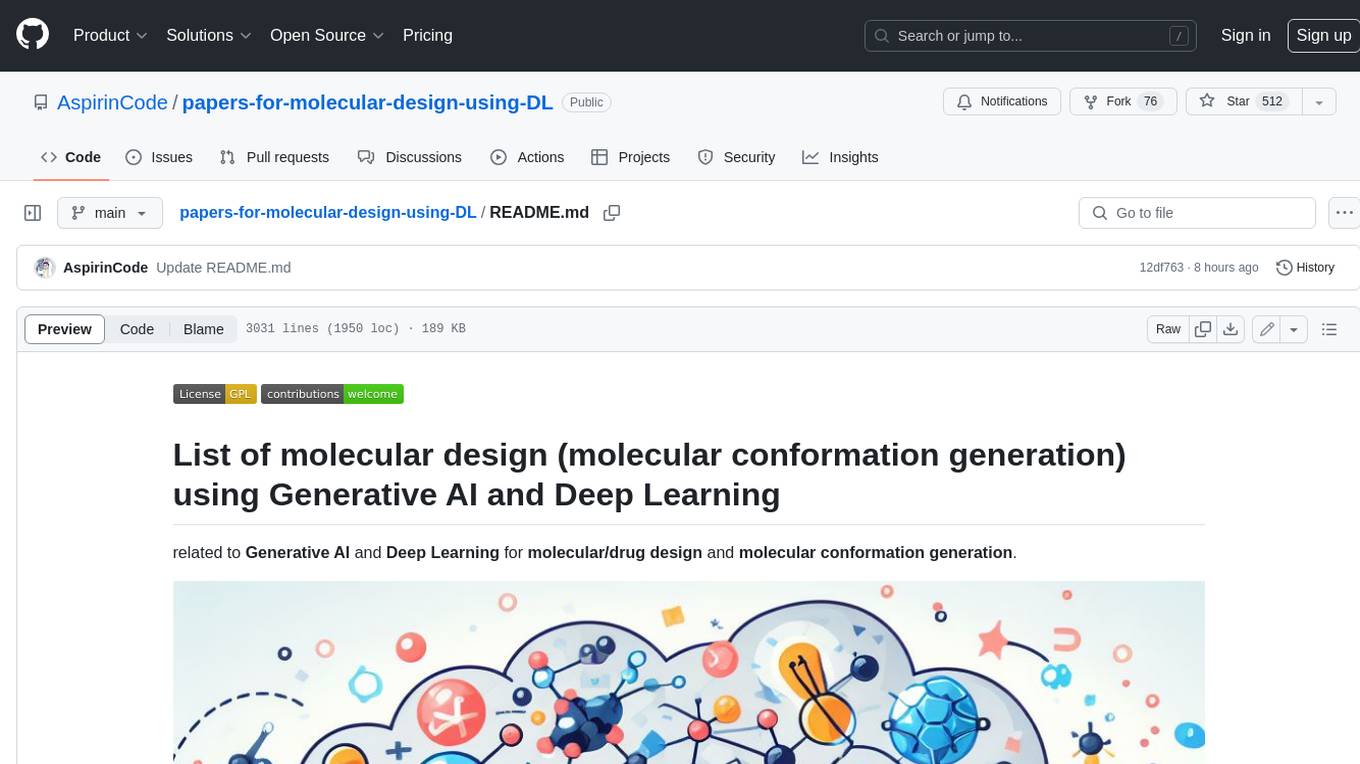
Awesome-Multimodal-LLM-for-Code
Multimodal Large Language Models for Code Generation under Multimodal Scenarios
Stars: 52
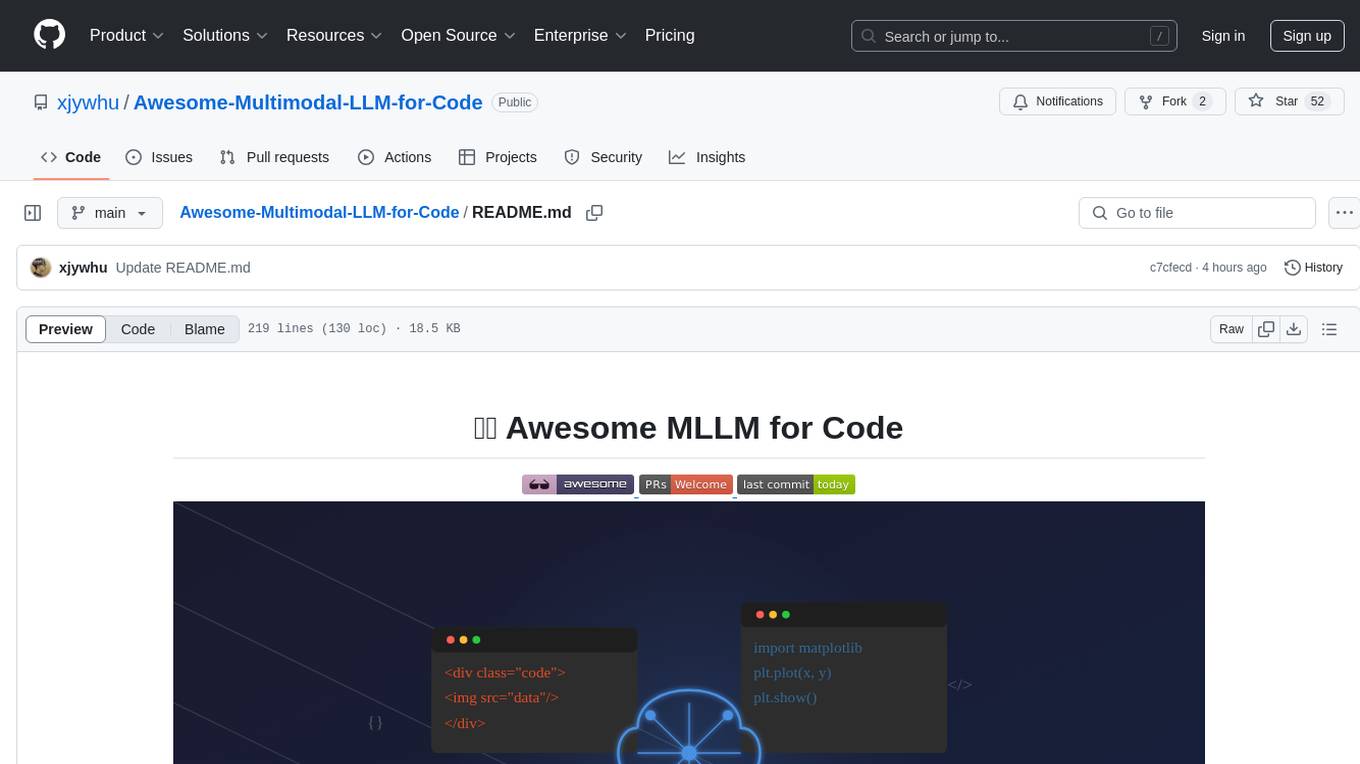
This repository contains papers, methods, benchmarks, and evaluations for code generation under multimodal scenarios. It covers UI code generation, scientific code generation, slide code generation, visually rich programming, logo generation, program repair, UML code generation, and general benchmarks.
README:
This repo includes papers about methods, benchmarks and evaluation for code generation under multimodal scenarios:
- UI Code Generation: Web front-end code generation, Mobile app UI code generation, etc。
- Scientific Code Generation: plot, chart, formula, etc.
- Slide code generation.
- Visually Rich Programming: programming problems with image examples.
- Logo: image generation through svg code generation.
- Program repair under above scenarios.
- UML code generation.
- General Benchmark.
You can directly click on the title to jump to the corresponding PDF link location
-
Design2Code: How Far Are We From Automating Front-End Engineering?. Chenglei Si, Yanzhe Zhang, Zhengyuan Yang, Ruibo Liu, Diyi Yang . NAACL 2025.
-
Unlocking the conversion of Web Screenshots into HTML Code with the WebSight Dataset. Hugo Laurençon, Léo Tronchon, Victor Sanh . Arxiv 2024.
-
VISION2UI: A Real-World Dataset with Layout for Code Generation from UI Designs. Yi Gui, Zhen Li, Yao Wan, Yemin Shi, Hongyu Zhang, Yi Su, Shaoling Dong, Xing Zhou, Wenbin Jiang . Arxiv 2024.
-
NLDesign: A UI Design Tool for Natural Language Interfaces Tianhao Zhang, Fu Peiguo, Jie Liu, Yihe Zhang, Xingmei Chen . ACM-TURC‘24 (2024.6.30)
-
Automatically Generating UI Code from Screenshot: A Divide-and-Conquer-Based Approach. Yuxuan Wan, Chaozheng Wang, Yi Dong, Wenxuan Wang, Shuqing Li, Yintong Huo, Michael R. Lyu . Arxiv 2024.
-
Web2Code: A Large-scale Webpage-to-Code Dataset and Evaluation Framework for Multimodal LLMs. Sukmin Yun, Haokun Lin, Rusiru Thushara, Mohammad Qazim Bhat, Yongxin Wang, Zutao Jiang, Mingkai Deng, Jinhong Wang, Tianhua Tao, Junbo Li, Haonan Li, Preslav Nakov, Timothy Baldwin, Zhengzhong Liu, Eric P. Xing, Xiaodan Liang, Zhiqiang Shen . NeurIPS 2024 Datasets and Benchmarks.
-
Prototype2Code: End-to-end Front-end Code Generation from UI Design Prototypes Shuhong Xiao, Yunnong Chen, Jiazhi Li, Liuqing Chen, Lingyun Sun, Tingting Zhou . Arxiv 2024.
-
Bridging Design and Development with Automated Declarative UI Code Generation Ting Zhou, Yanjie Zhao, Xinyi Hou, Xiaoyu Sun, Kai Chen, Haoyu Wang . Arxiv 2024.
-
Sketch2Code: Evaluating Vision-Language Models for Interactive Web Design Prototyping Ryan Li, Yanzhe Zhang, Diyi Yang . Arxiv 2024.
-
Interaction2Code: How Far Are We From Automatic Interactive Webpage Generation? Jingyu Xiao, Yuxuan Wan, Yintong Huo, Zhiyao Xu, Michael R.Lyu . Arxiv 2024.
-
UIClip: A Data-driven Model for Assessing User Interface Design Jason Wu, Yi-Hao Peng, Xin Yue Li, Amanda Swearngin, Jeffrey P. Biham, Jeffrey Nichols . UIST 2024.
-
WAFFLE: Multi-Modal Model for Automated Front-End Development Shanchao Liang, Nan Jiang, Shangshu Qian, Lin Tan . Arxiv 2024.
-
MRWeb: An Exploration of Generating Multi-Page Resource-Aware Web Code from UI Designs Yuxuan Wan, Yi Dong, Jingyu Xiao, Yintong Huo, Wenxuan Wang, Michael R. Lyu . Arxiv 2024.
-
UICopilot: Automating UI Synthesis via Hierarchical Code Generation from Webpage Designs * Yi Gui, Yao Wan, Zhen Li, Zhongyi Zhang, Dongping Chen, Hongyu Zhang, Yi Su, Bohua Chen, Xing Zhou, Wenbin Jiang, Xiangliang Zhang. WWW 2025 (Oral).
-
WebCode2M: A Real-World Dataset for Code Generation from Webpage Designs * Yi Gui, Zhen Li, Yao Wan*, Yemin Shi, Hongyu Zhang, Yi Su, Bohua Chen, Dongping Chen, Siyuan Wu, Xing Zhou, Wenbin Jiang, Hai Jin, Xiangliang Zhang. WWW 2025 (Oral).
-
Zero-Shot Prompting Approaches for LLM-based Graphical User Interface Generation * Kristian Kolthoff, Felix Kretzer, Lennart Fiebig, Christian Bartelt, Alexander Maedche, Simone Paolo Ponzetto.Arxiv 2024.12.
-
Towards Human-AI Synergy in UI Design: Enhancing Multi-Agent Based UI Generation with Intent Clarification and Alignment *Mingyue Yuan, Jieshan Chen, Yongquan Hu, Sidong Feng, Mulong Xie, Gelareh Mohammadi, Zhenchang Xing, Aaron Quigley.Arxiv 2024.12.28
-
Frontend Diffusion: Empowering Self-Representation of Junior Researchers and Designers Through Agentic Workflows *Zijian Ding, Qinshi Zhang, Mohan Chi, Ziyi Wang. Arxiv 2025.
-
Advancing vision-language models in front-end development via data synthesis Tong Ge, Yashu Liu, Jieping Ye, Tianyi Li, Chao Wang . Arxiv 2025.3.3.
-
UICrit: Enhancing Automated Design Evaluation with a UICritique Dataset Peitong Duan, Chin-yi Chen, Gang Li, Bjoern Hartmann, Yang Li. Arxiv 2024.7.11 (UIST 2024).
-
Plot2Code: A Comprehensive Benchmark for Evaluating Multi-modal Large Language Models in Code Generation from Scientific Plots. Chengyue Wu, Yixiao Ge, Qiushan Guo, Jiahao Wang, Zhixuan Liang, Zeyu Lu, Ying Shan, Ping Luo . Arxiv 2024.
-
MatPlotAgent: Method and Evaluation for LLM-Based Agentic Scientific Data Visualization. Zhiyu Yang, Zihan Zhou, Shuo Wang, Xin Cong, Xu Han, Yukun Yan, Zhenghao Liu, Zhixing Tan, Pengyuan Liu, Dong Yu, Zhiyuan Liu, Xiaodong Shi, Maosong Sun . Arxiv 2024.
-
ChartMimic: Evaluating LMM's Cross-Modal Reasoning Capability via Chart-to-Code Generation. Chufan Shi, Cheng Yang, Yaxin Liu, Bo Shui, Junjie Wang, Mohan Jing, Linran Xu, Xinyu Zhu, Siheng Li, Yuxiang Zhang, Gongye Liu, Xiaomei Nie, Deng Cai, Yujiu Yang .* Arxiv 2024.
-
From Words to Structured Visuals: A Benchmark and Framework for Text-to-Diagram Generation and Editing. Jingxuan Wei, Cheng Tan, Qi Chen, Gaowei Wu, Siyuan Li, Zhangyang Gao, Linzhuang Sun, Bihui Yu, Ruifeng Guo .* Arxiv 2024.
-
Is GPT-4V (ision) All You Need for Automating Academic Data Visualization? Exploring Vision-Language Models’ Capability in Reproducing Academic Charts. Zhehao Zhang, Weicheng Ma, Soroush Vosoughi .* EMNLP 2024 (Findings).
-
Drawing Pandas: A Benchmark for LLMs in Generating Plotting Code. Timur Galimzyanov, Sergey Titov, Yaroslav Golubev, Egor Bogomolov .* Arxiv 2024.
-
ChartCoder: Advancing Multimodal Large Language Model for Chart-to-Code Generation. Xuanle Zhao, Xianzhen Luo, Qi Shi, Chi Chen, Shuo Wang, Wanxiang Che, Zhiyuan Liu, Maosong Sun.* Arxiv 2025.1.
-
MMCode: Evaluating Multi-Modal Code Large Language Models with Visually Rich Programming Problems. Kaixin Li, Yuchen Tian, Qisheng Hu, Ziyang Luo, Jing Ma . Arxiv 2024.
-
HumanEval-V: Evaluating Visual Understanding and Reasoning Abilities of Large Multimodal Models Through Coding Tasks. Fengji Zhang, Linquan Wu, Huiyu Bai, Guancheng Lin, Xiao Li, Xiao Yu, Yue Wang, Bei Chen, Jacky Keung . Arxiv 2024.
-
DynEx: Dynamic Code Synthesis with Structured Design Exploration for Accelerated Exploratory Programming. Jenny Ma, Karthik Sreedhar, Vivian Liu, Sitong Wang, Pedro Alejandro Perez, Riya Sahni, Lydia B. Chilton . Arxiv 2024.
-
ScratchEval: Are GPT-4o Smarter than My Child? Evaluating Large Multimodal Models with Visual Programming Challenges. Rao Fu, Ziyang Luo, Hongzhan Lin, Zhen Ye, Jing Ma . Arxiv 2024.
-
StarVector: Generating Scalable Vector Graphics Code from Images and Text Juan A. Rodriguez, Abhay Puri, Shubham Agarwal, Issam H. Laradji, Pau Rodriguez, Sai Rajeswar, David Vazquez, Christopher Pal, Marco Pedersoli. Arxiv 2023. (CVPR 2025)
-
LogoMotion: Visually Grounded Code Generation for Content-Aware Animation. Vivian Liu, Rubaiat Habib Kazi, Li-Yi Wei, Matthew Fisher, Timothy Langlois, Seth Walker, Lydia Chilton . Arxiv 2024 (CHI 2025).
-
Chat2SVG: Vector Graphics Generation with Large Language Models and Image Diffusion Models. Ronghuan Wu, Wanchao Su, Jing Liao . Arxiv 2024 (CVPR 2025).
-
Can Large Language Models Understand Symbolic Graphics Programs? Zeju Qiu, Weiyang Liu, Haiwen Feng, Zhen Liu, Tim Z. Xiao, Katherine M. Collins, Joshua B. Tenenbaum, Adrian Weller, Michael J. Black, Bernhard Schölkopf. ICLR 2025 (Spotlight).
-
LLM4SVG: Empowering LLMs to Understand and Generate Complex Vector Graphics Ximing Xing, Juncheng Hu, Guotao Liang, Jing Zhang, Dong Xu, Qian Yu. CVPR 2025.
-
AutoPresent: Designing Structured Visuals from Scratch. Jiaxin Ge, Zora Zhiruo Wang, Xuhui Zhou, Yi-Hao Peng, Sanjay Subramanian, Qinyue Tan, Maarten Sap, Alane Suhr, Daniel Fried, Graham Neubig, Trevor Darrell . Arxiv 2025 (CVPR 2025).
-
PPTAgent: Generating and Evaluating Presentations Beyond Text-to-Slides. Hao Zheng, Xinyan Guan, Hao Kong, Jia Zheng, Hongyu Lin, Yaojie Lu, Ben He, Xianpei Han, Le Sun . Arxiv 2025.
-
SWE-bench Multimodal: Do AI Systems Generalize to Visual Software Domains? John Yang, Carlos E. Jimenez, Alex L. Zhang, Kilian Lieret, Joyce Yang, Xindi Wu, Ori Press, Niklas Muennighoff, Gabriel Synnaeve, Karthik R. Narasimhan, Diyi Yang, Sida I. Wang, Ofir Press. ICLR 2025.
-
DesignRepair: Dual-Stream Design Guideline-Aware Frontend Repair with Large Language Models * Mingyue Yuan, Jieshan Chen, Zhenchang Xing, Aaron Quigley, Yuyu Luo, Gelareh Mohammadi, Qinghua Lu, Liming Zhu.* ICSE 2025.
-
CodeV: Issue Resolving with Visual Data Linhao Zhang, Daoguang Zan, Quanshun Yang, Zhirong Huang, Dong Chen, Bo Shen, Tianyu Liu, Yongshun Gong, Pengjie Huang, Xudong Lu, Guangtai Liang, Lizhen Cui, Qianxiang Wang . Arxiv 2024.
- From Image to UML: First Results of Image-Based UML Diagram Generation using LLMs Arie van Deursen, Eduard C. Groen . LLM4MDE 2024.
-
Image2Struct: Benchmarking Structure Extraction for Vision-Language Models Josselin Somerville Roberts, Tony Lee, Chi Heem Wong, Michihiro Yasunaga, Yifan Mai, Percy Liang . NeurIPS 2024 Datasets and Benchmarks.
-
FullStack Bench: Evaluating LLMs as Full Stack Coders Siyao Liu, He Zhu, Jerry Liu, Shulin Xin, Aoyan Li, Rui Long, Li Chen, Jack Yang, Jinxiang Xia, Z.Y. Peng, Shukai Liu, Zhaoxiang Zhang, Jing Mai, Ge Zhang, Wenhao Huang, Kai Shen, Liang Xiang . Arxiv 2024.
-
Empowering Agile-Based Generative Software Development through Human-AI Teamwork Sai Zhang, Zhenchang Xing, Ronghui Guo, Fangzhou Xu, Lei Chen, Zhaoyuan Zhang, Xiaowang Zhang, Zhiyong Feng, Zhiqiang Zhuang . TOSEM 2024.
-
Automated LaTeX Code Generation from Handwritten Mathematical Expressions Jayaprakash Sundararaj, Akhil Vyas, Benjamin Gonzalez-Maldonado. Arxiv 2024.
This is an active repository and your contributions are always welcome! Before you add papers/tools into the awesome list, please make sure that:
- First, think about which category the work should belong to.
- The paper or tools is related to Multimodal Large Language Models (MLLMs) for code generation.
- The paper should be inserted in the correct position in chronological order (publication/arxiv release time).
- The link to paper should be the arxiv page, not the pdf page if this is a paper posted on arxiv.
- If the paper is accpeted, please use the correct publication venue instead of arxiv.
For Tasks:
Click tags to check more tools for each tasksFor Jobs:
Alternative AI tools for Awesome-Multimodal-LLM-for-Code
Similar Open Source Tools

Awesome-Multimodal-LLM-for-Code
This repository contains papers, methods, benchmarks, and evaluations for code generation under multimodal scenarios. It covers UI code generation, scientific code generation, slide code generation, visually rich programming, logo generation, program repair, UML code generation, and general benchmarks.
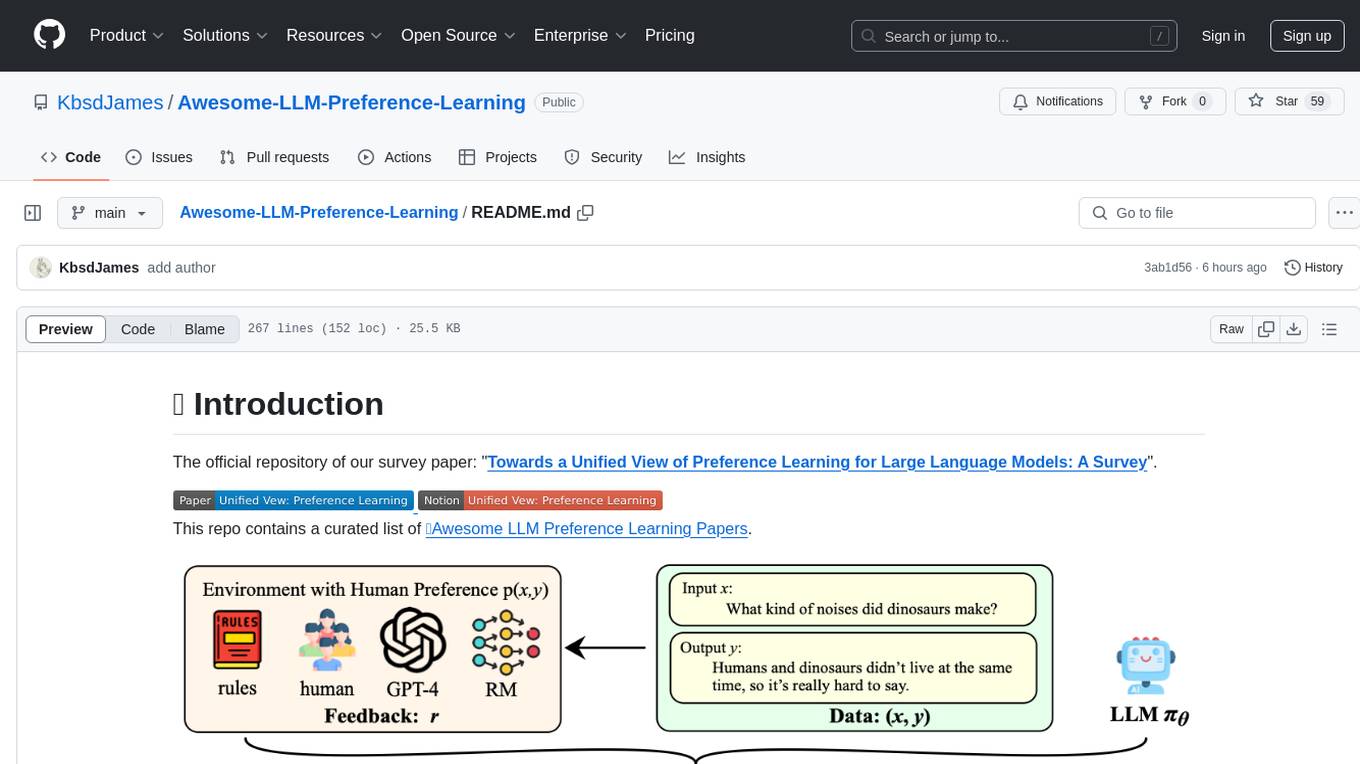
Awesome-LLM-Preference-Learning
The repository 'Awesome-LLM-Preference-Learning' is the official repository of a survey paper titled 'Towards a Unified View of Preference Learning for Large Language Models: A Survey'. It contains a curated list of papers related to preference learning for Large Language Models (LLMs). The repository covers various aspects of preference learning, including on-policy and off-policy methods, feedback mechanisms, reward models, algorithms, evaluation techniques, and more. The papers included in the repository explore different approaches to aligning LLMs with human preferences, improving mathematical reasoning in LLMs, enhancing code generation, and optimizing language model performance.
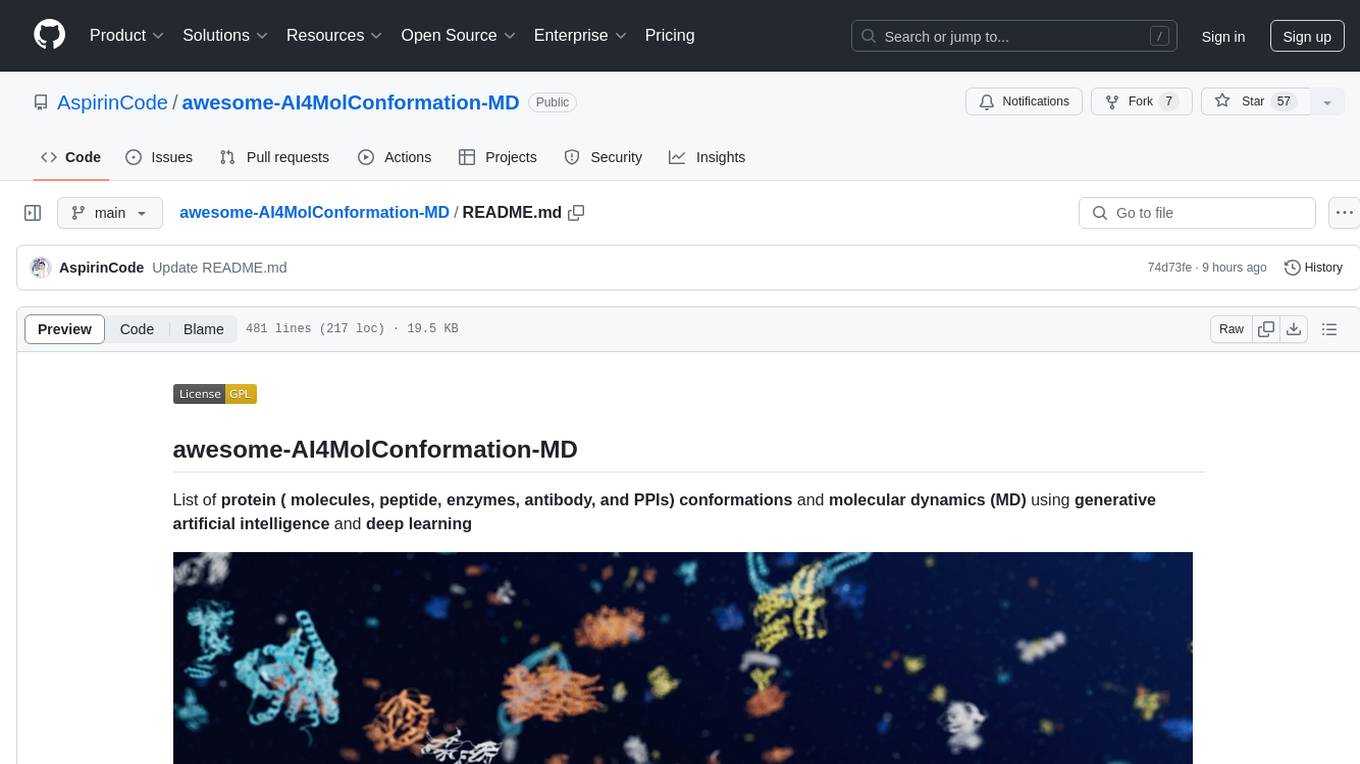
awesome-AI4MolConformation-MD
The 'awesome-AI4MolConformation-MD' repository focuses on protein conformations and molecular dynamics using generative artificial intelligence and deep learning. It provides resources, reviews, datasets, packages, and tools related to AI-driven molecular dynamics simulations. The repository covers a wide range of topics such as neural networks potentials, force fields, AI engines/frameworks, trajectory analysis, visualization tools, and various AI-based models for protein conformational sampling. It serves as a comprehensive guide for researchers and practitioners interested in leveraging AI for studying molecular structures and dynamics.
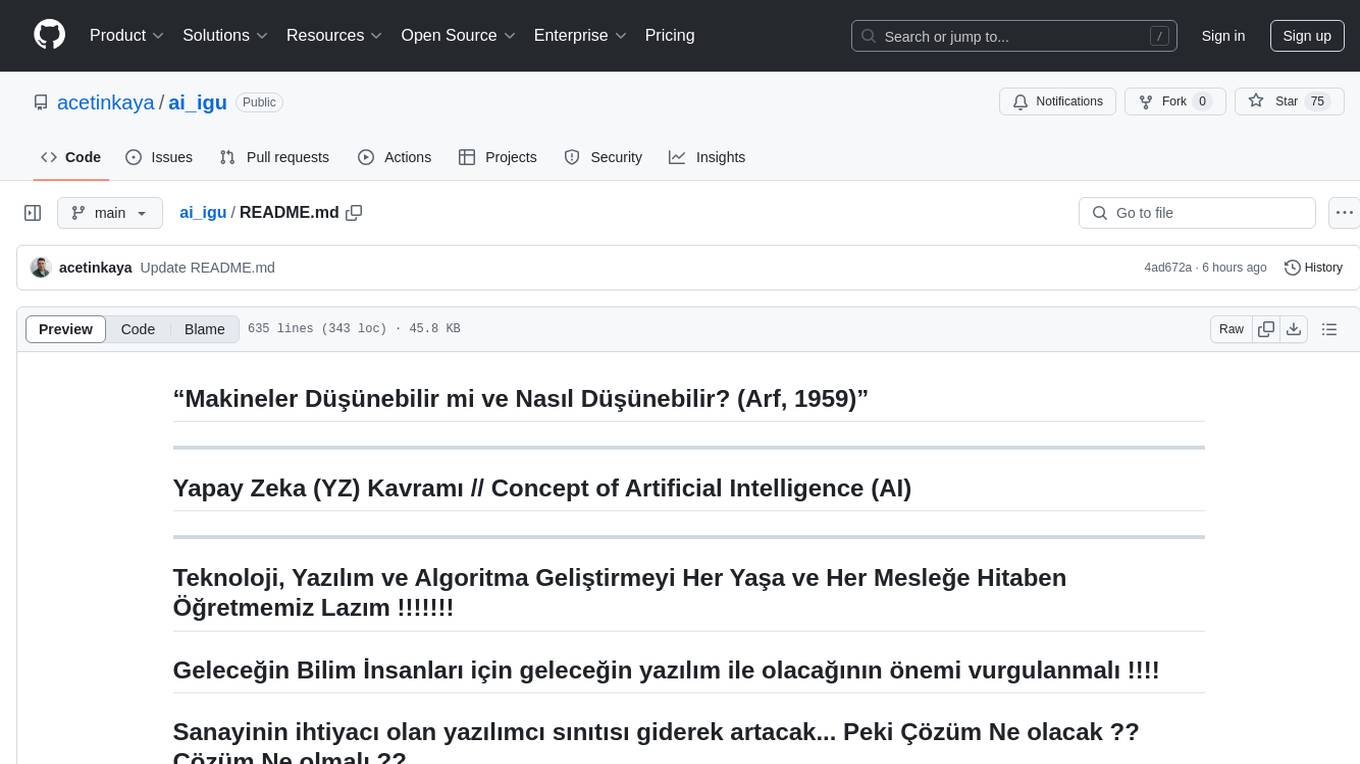
ai_igu
AI-IGU is a GitHub repository focused on Artificial Intelligence (AI) concepts, technology, software development, and algorithm improvement for all ages and professions. It emphasizes the importance of future software for future scientists and the increasing need for software developers in the industry. The repository covers various topics related to AI, including machine learning, deep learning, data mining, data science, big data, and more. It provides educational materials, practical examples, and hands-on projects to enhance software development skills and create awareness in the field of AI.
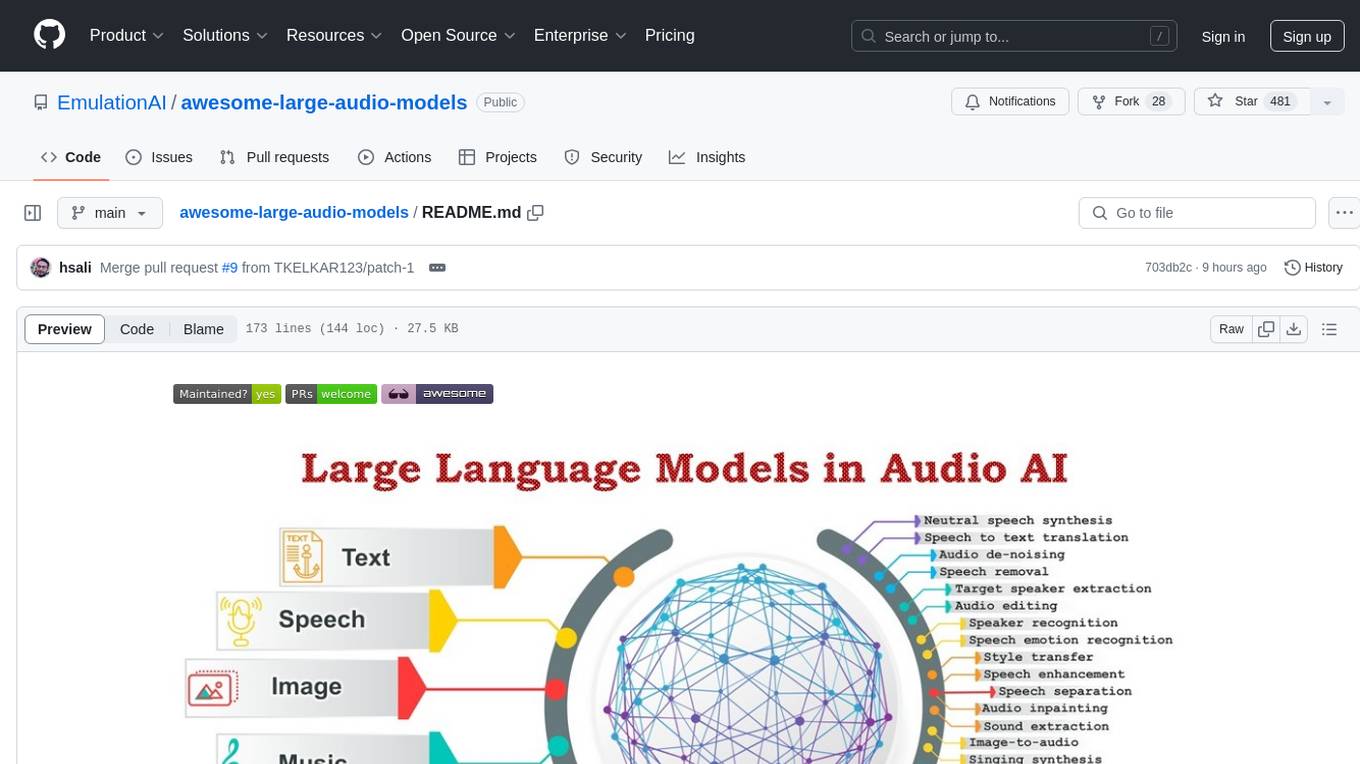
awesome-large-audio-models
This repository is a curated list of awesome large AI models in audio signal processing, focusing on the application of large language models to audio tasks. It includes survey papers, popular large audio models, automatic speech recognition, neural speech synthesis, speech translation, other speech applications, large audio models in music, and audio datasets. The repository aims to provide a comprehensive overview of recent advancements and challenges in applying large language models to audio signal processing, showcasing the efficacy of transformer-based architectures in various audio tasks.
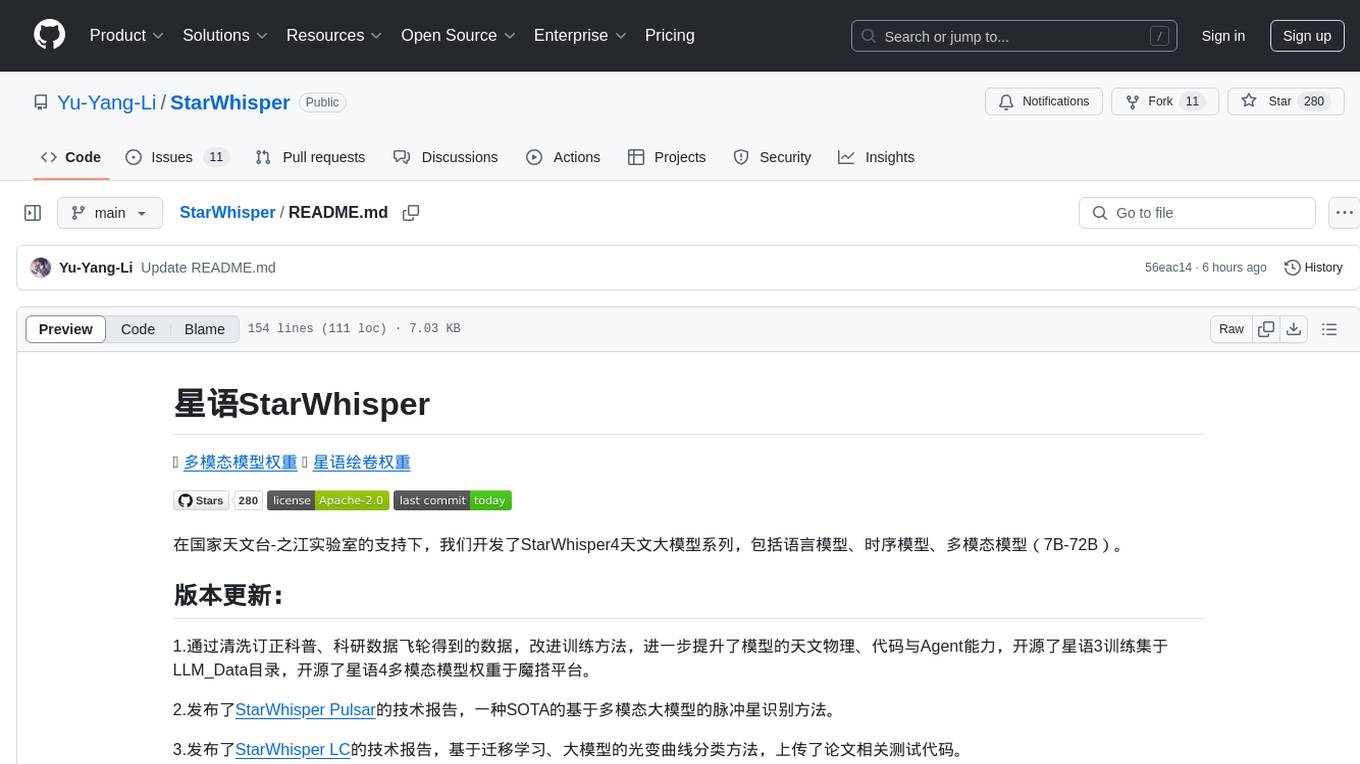
StarWhisper
StarWhisper is a multi-modal model repository developed under the support of the National Astronomical Observatory-Zhijiang Laboratory. It includes language models, temporal models, and multi-modal models ranging from 7B to 72B. The repository provides pre-trained models and technical reports for tasks such as pulsar identification, light curve classification, and telescope control. It aims to integrate astronomical knowledge using large models and explore the possibilities of solving specific astronomical problems through multi-modal approaches.
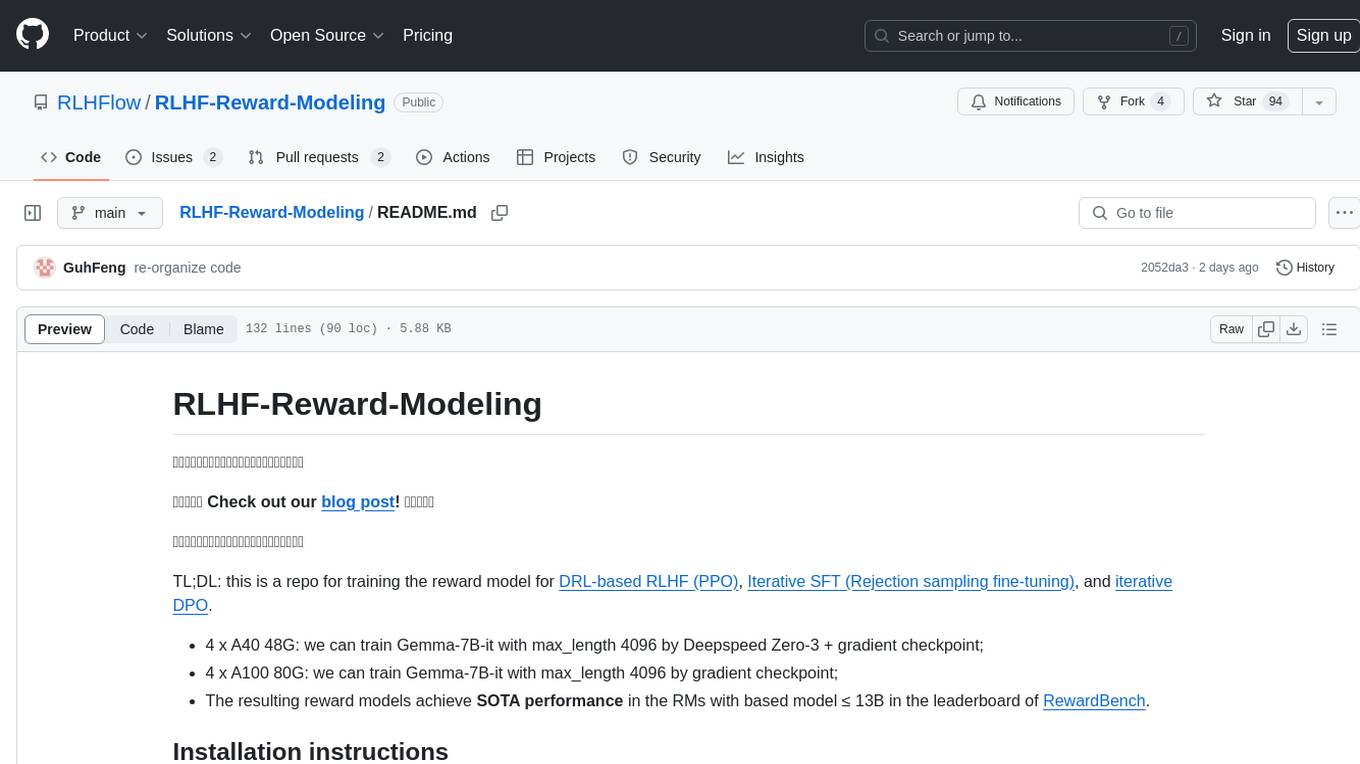
RLHF-Reward-Modeling
This repository, RLHF-Reward-Modeling, is dedicated to training reward models for DRL-based RLHF (PPO), Iterative SFT, and iterative DPO. It provides state-of-the-art performance in reward models with a base model size of up to 13B. The installation instructions involve setting up the environment and aligning the handbook. Dataset preparation requires preprocessing conversations into a standard format. The code can be run with Gemma-2b-it, and evaluation results can be obtained using provided datasets. The to-do list includes various reward models like Bradley-Terry, preference model, regression-based reward model, and multi-objective reward model. The repository is part of iterative rejection sampling fine-tuning and iterative DPO.
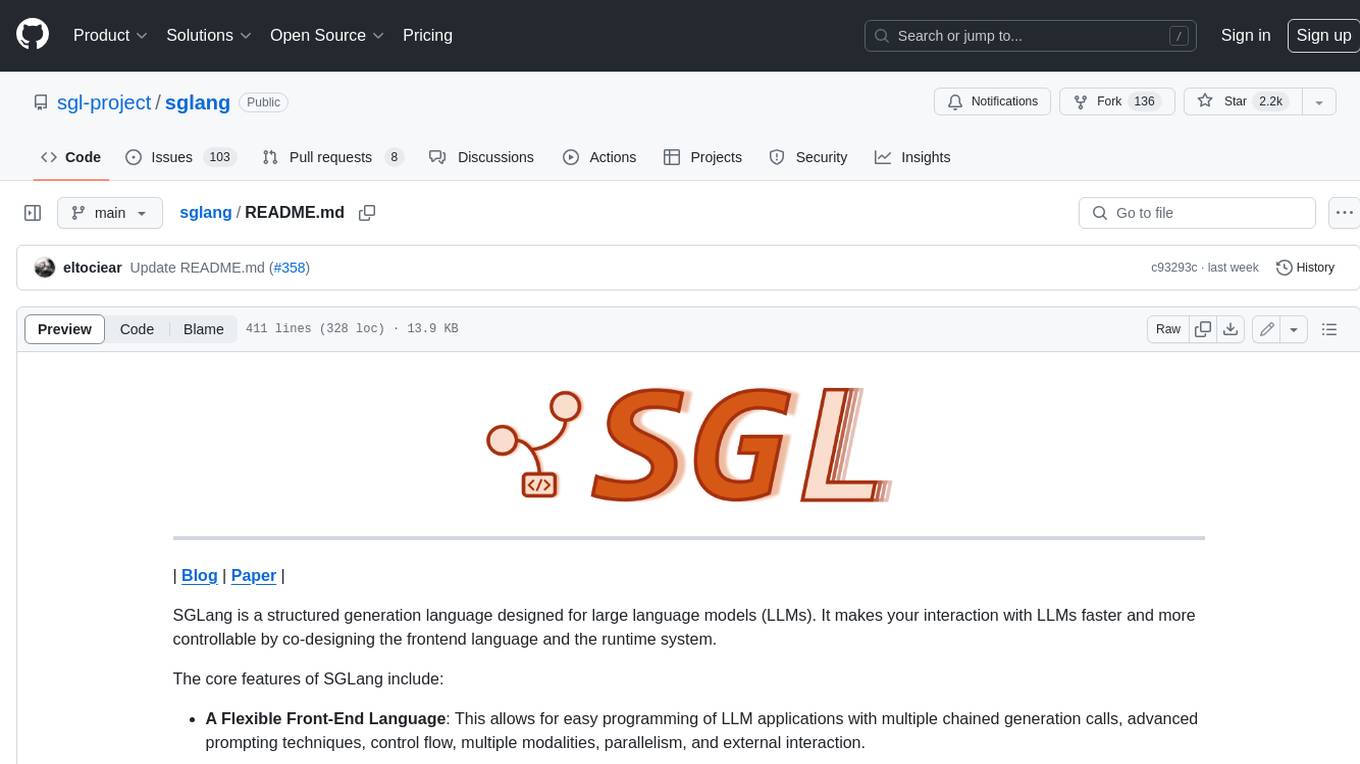
sglang
SGLang is a structured generation language designed for large language models (LLMs). It makes your interaction with LLMs faster and more controllable by co-designing the frontend language and the runtime system. The core features of SGLang include: - **A Flexible Front-End Language**: This allows for easy programming of LLM applications with multiple chained generation calls, advanced prompting techniques, control flow, multiple modalities, parallelism, and external interaction. - **A High-Performance Runtime with RadixAttention**: This feature significantly accelerates the execution of complex LLM programs by automatic KV cache reuse across multiple calls. It also supports other common techniques like continuous batching and tensor parallelism.
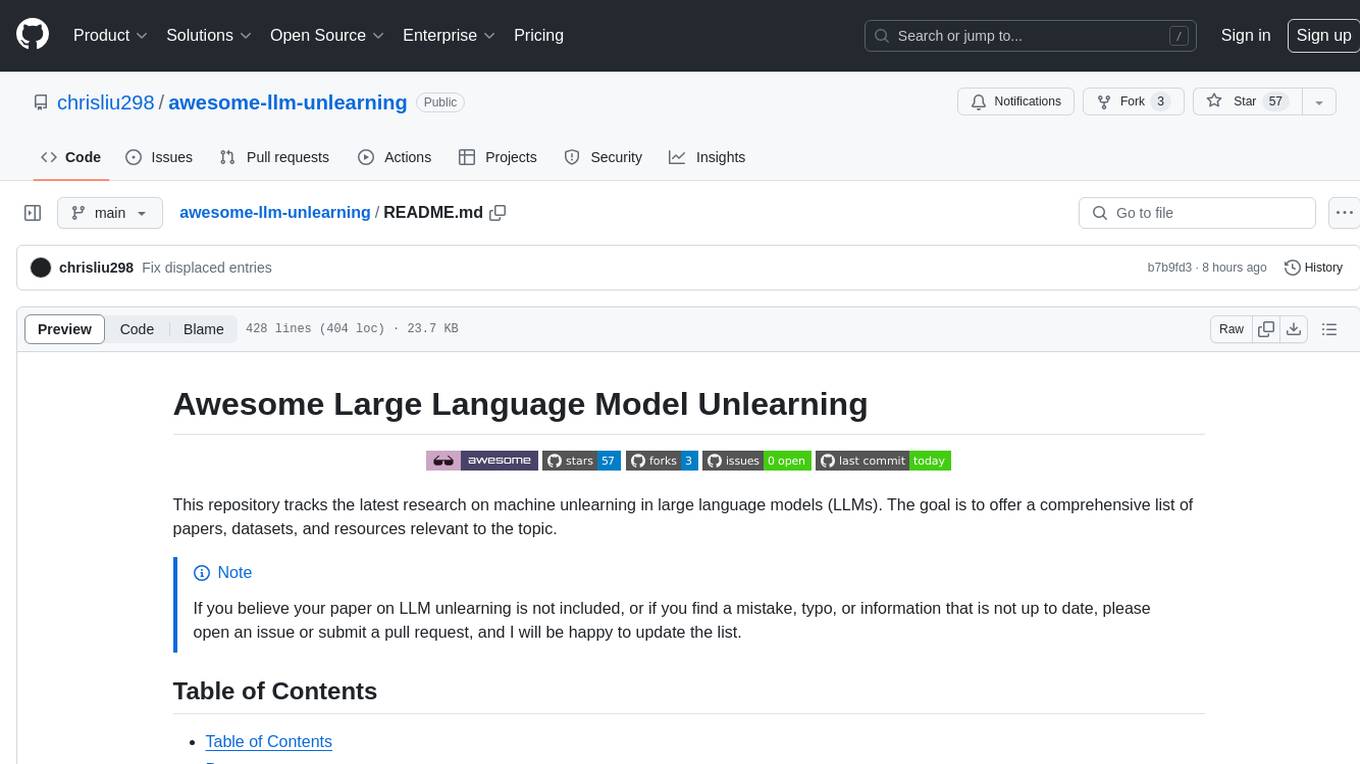
awesome-llm-unlearning
This repository tracks the latest research on machine unlearning in large language models (LLMs). It offers a comprehensive list of papers, datasets, and resources relevant to the topic.
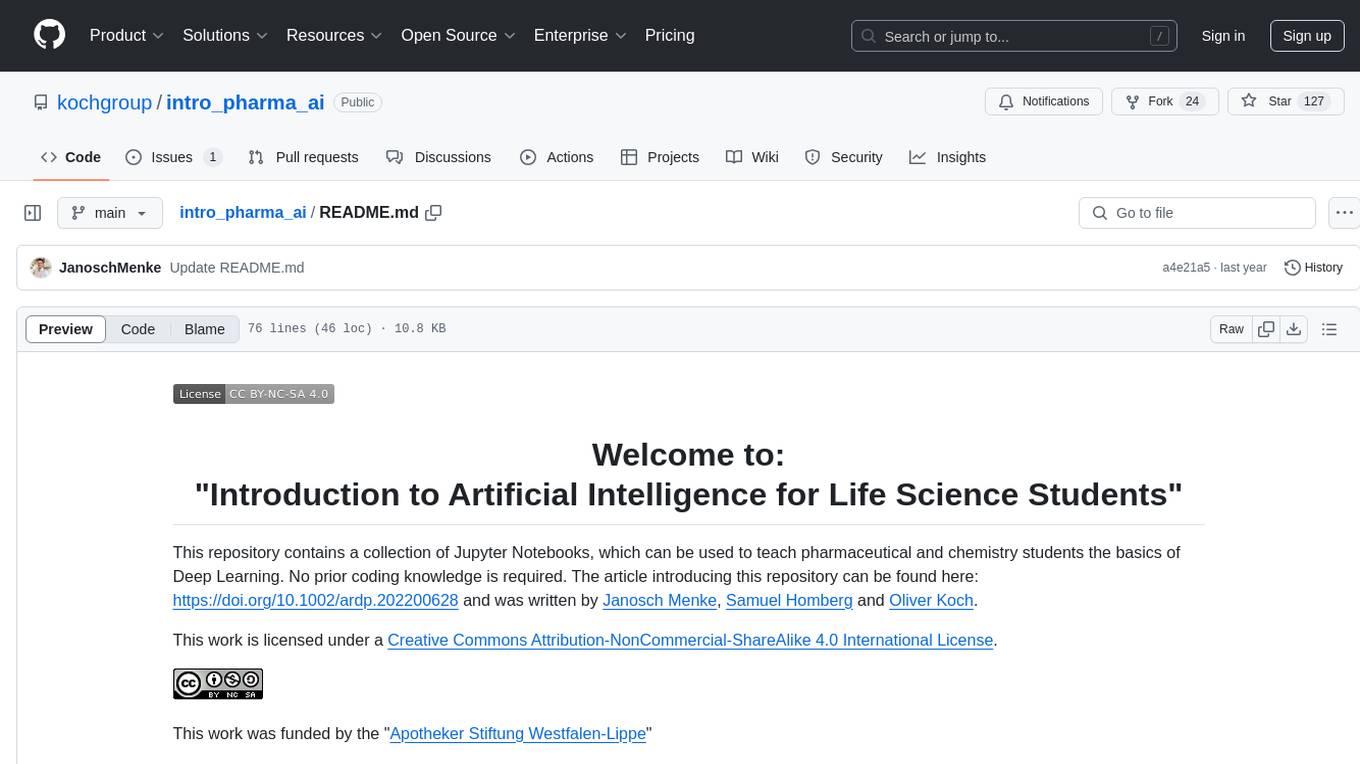
intro_pharma_ai
This repository serves as an educational resource for pharmaceutical and chemistry students to learn the basics of Deep Learning through a collection of Jupyter Notebooks. The content covers various topics such as Introduction to Jupyter, Python, Cheminformatics & RDKit, Linear Regression, Data Science, Linear Algebra, Neural Networks, PyTorch, Convolutional Neural Networks, Transfer Learning, Recurrent Neural Networks, Autoencoders, Graph Neural Networks, and Summary. The notebooks aim to provide theoretical concepts to understand neural networks through code completion, but instructors are encouraged to supplement with their own lectures. The work is licensed under a Creative Commons Attribution-NonCommercial-ShareAlike 4.0 International License.
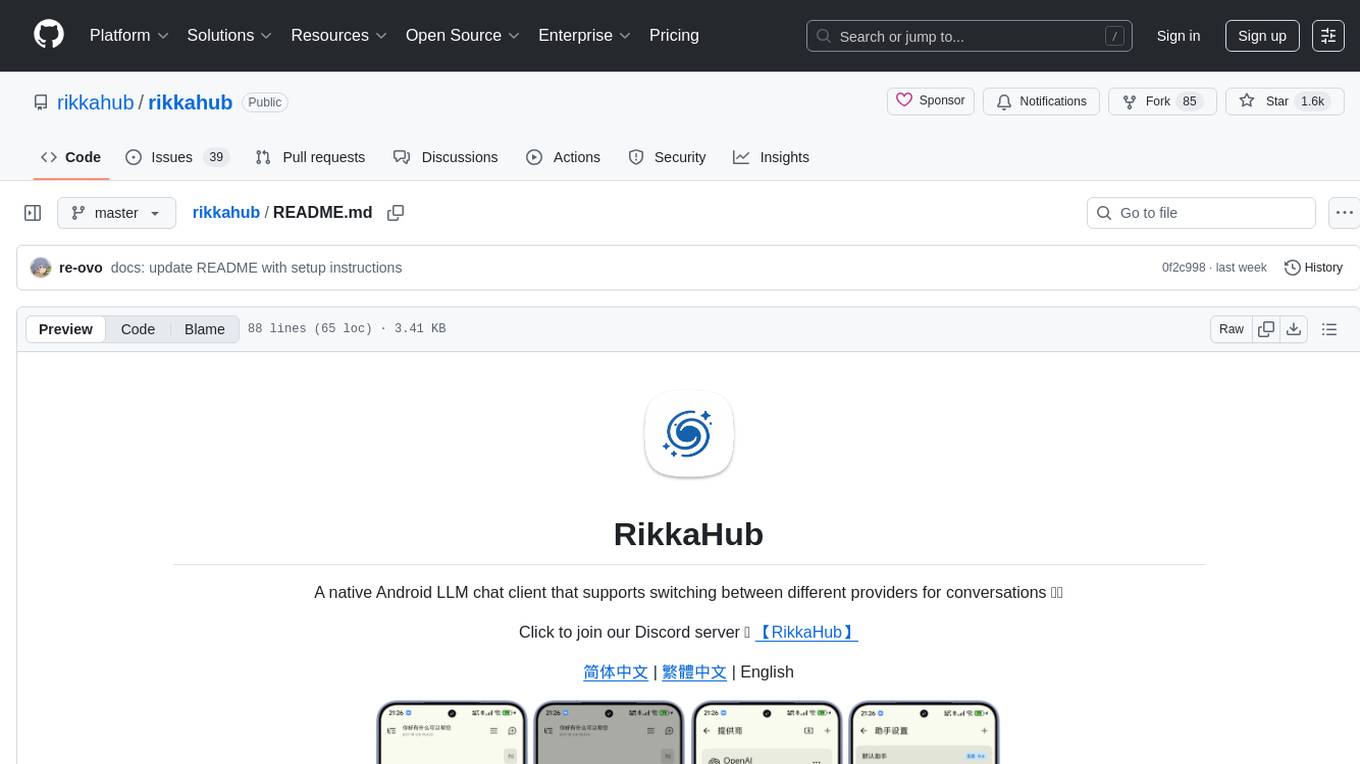
rikkahub
RikkaHub is a native Android LLM chat client that supports switching between different providers for conversations. It features a modern Android app design with dark mode, support for multiple provider types, multimodal input support, Markdown rendering, search capabilities, prompt variables, QR code export/import, agent customization, ChatGPT-like memory feature, AI translation, and custom HTTP request headers and bodies. The project is developed using Kotlin, Koin, Jetpack Compose, DataStore, Room, Coil, Material You, Navigation Compose, Okhttp, kotlinx.serialization, and compose-icons/lucide.
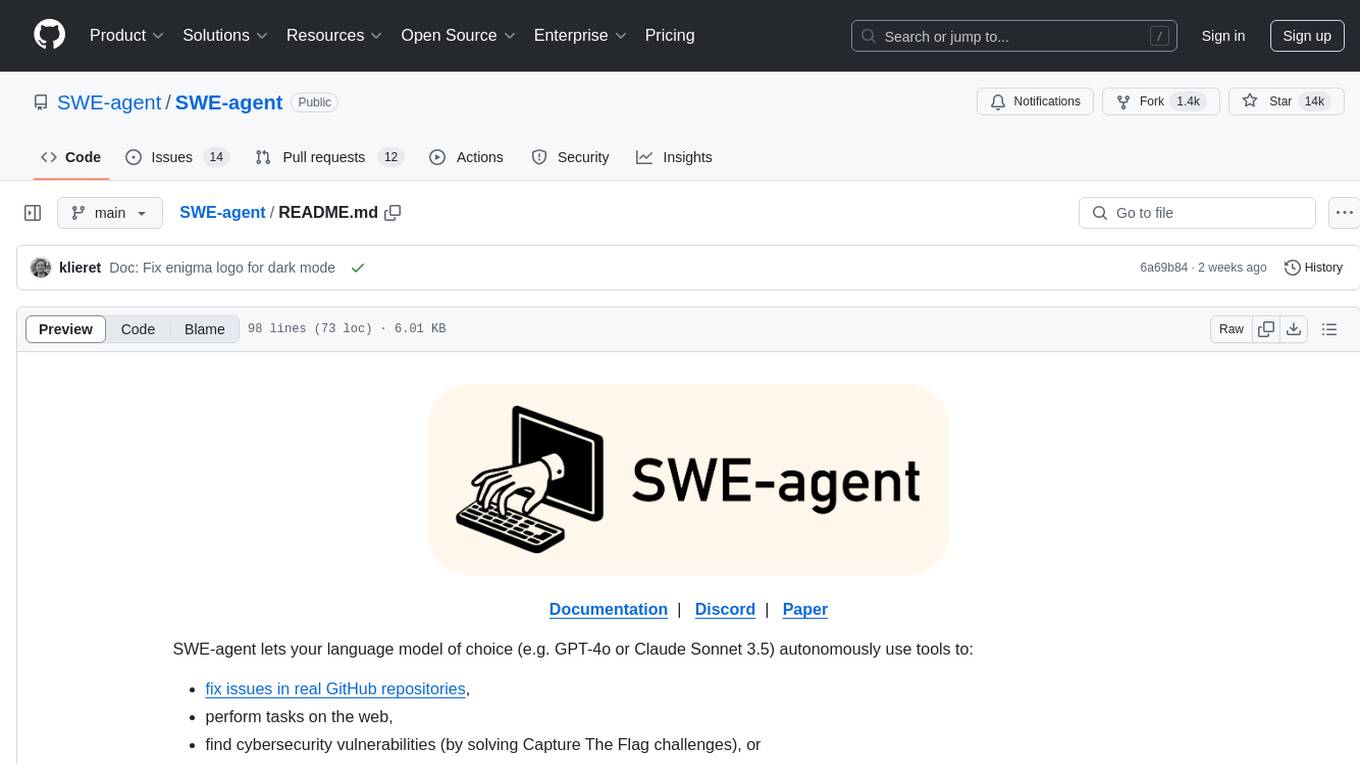
SWE-agent
SWE-agent is a tool that allows language models to autonomously fix issues in GitHub repositories, perform tasks on the web, find cybersecurity vulnerabilities, and handle custom tasks. It uses configurable agent-computer interfaces (ACIs) to interact with isolated computer environments. The tool is built and maintained by researchers from Princeton University and Stanford University.
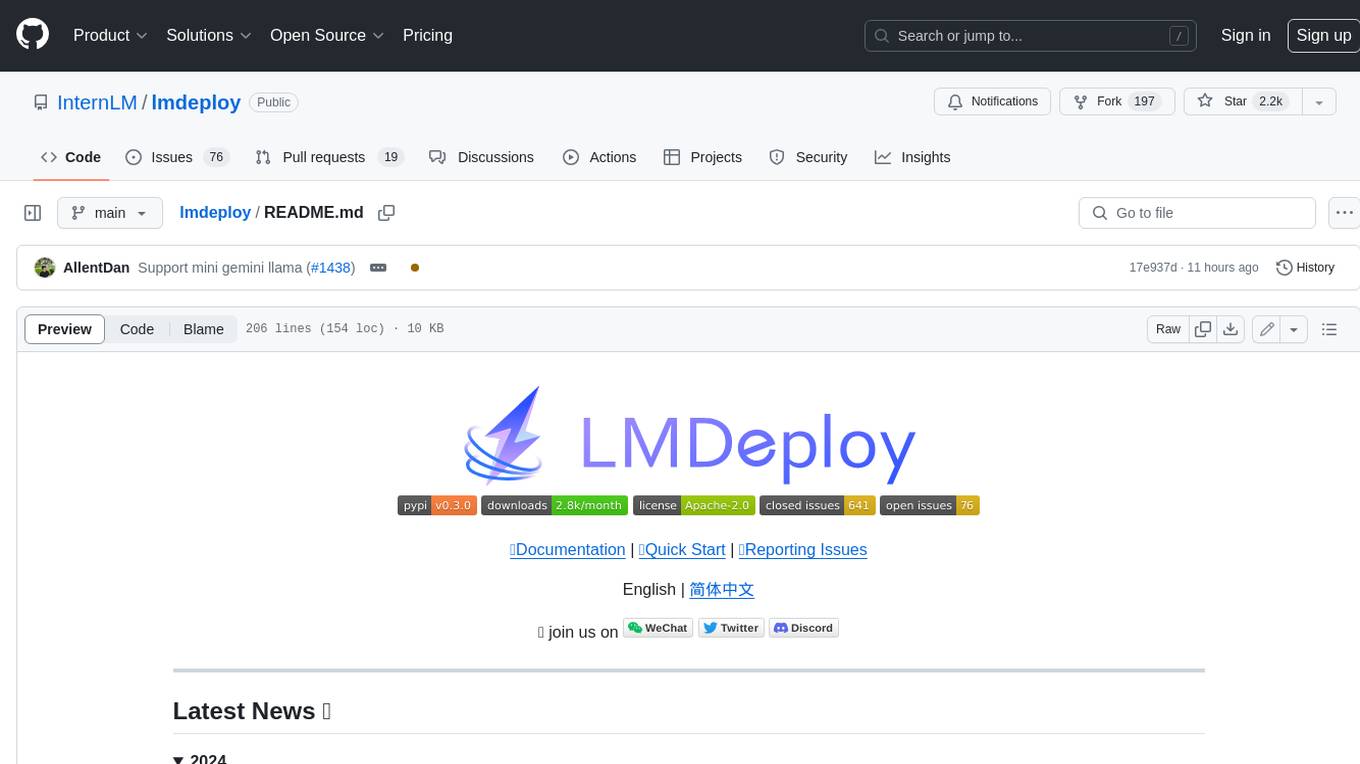
lmdeploy
LMDeploy is a toolkit for compressing, deploying, and serving LLM, developed by the MMRazor and MMDeploy teams. It has the following core features: * **Efficient Inference** : LMDeploy delivers up to 1.8x higher request throughput than vLLM, by introducing key features like persistent batch(a.k.a. continuous batching), blocked KV cache, dynamic split&fuse, tensor parallelism, high-performance CUDA kernels and so on. * **Effective Quantization** : LMDeploy supports weight-only and k/v quantization, and the 4-bit inference performance is 2.4x higher than FP16. The quantization quality has been confirmed via OpenCompass evaluation. * **Effortless Distribution Server** : Leveraging the request distribution service, LMDeploy facilitates an easy and efficient deployment of multi-model services across multiple machines and cards. * **Interactive Inference Mode** : By caching the k/v of attention during multi-round dialogue processes, the engine remembers dialogue history, thus avoiding repetitive processing of historical sessions.
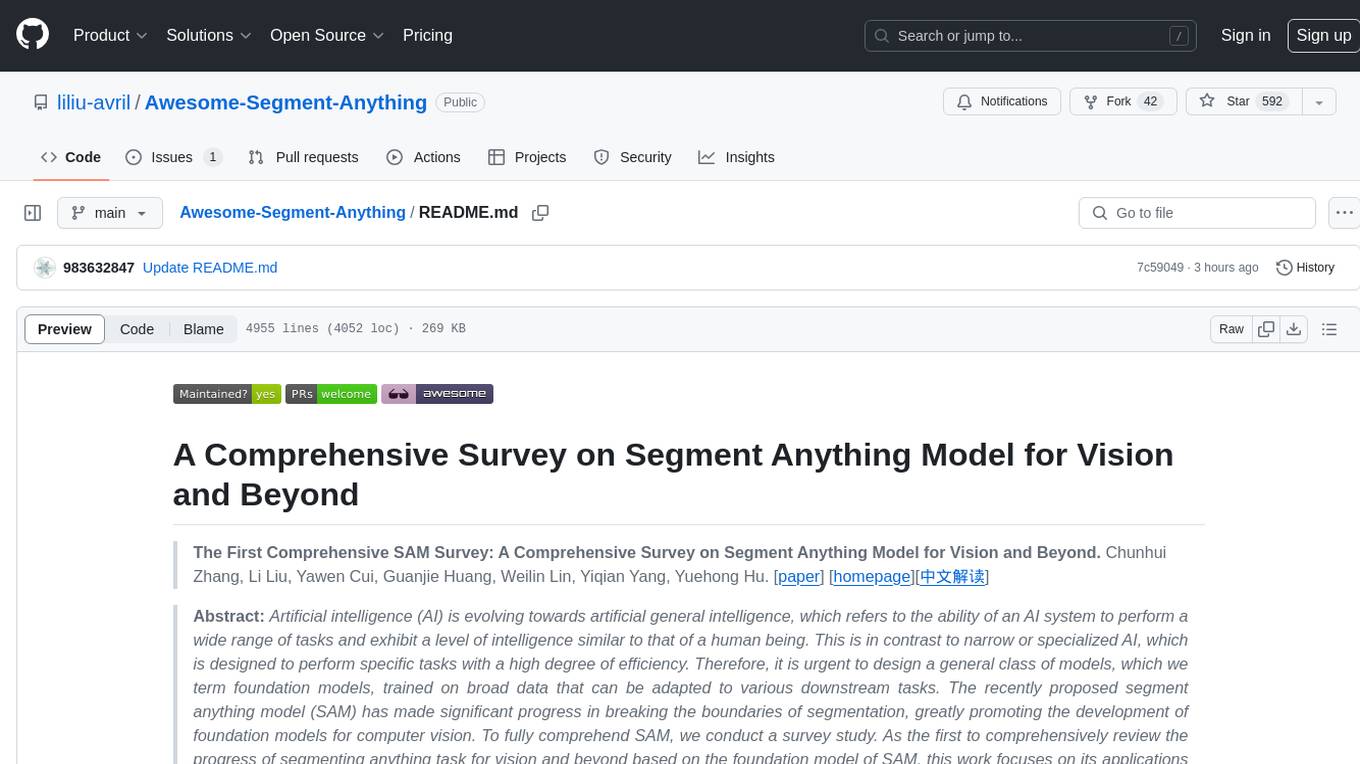
Awesome-Segment-Anything
Awesome-Segment-Anything is a powerful tool for segmenting and extracting information from various types of data. It provides a user-friendly interface to easily define segmentation rules and apply them to text, images, and other data formats. The tool supports both supervised and unsupervised segmentation methods, allowing users to customize the segmentation process based on their specific needs. With its versatile functionality and intuitive design, Awesome-Segment-Anything is ideal for data analysts, researchers, content creators, and anyone looking to efficiently extract valuable insights from complex datasets.
For similar tasks

Awesome-Multimodal-LLM-for-Code
This repository contains papers, methods, benchmarks, and evaluations for code generation under multimodal scenarios. It covers UI code generation, scientific code generation, slide code generation, visually rich programming, logo generation, program repair, UML code generation, and general benchmarks.

LLM-PLSE-paper
LLM-PLSE-paper is a repository focused on the applications of Large Language Models (LLMs) in Programming Language and Software Engineering (PL/SE) domains. It covers a wide range of topics including bug detection, specification inference and verification, code generation, fuzzing and testing, code model and reasoning, code understanding, IDE technologies, prompting for reasoning tasks, and agent/tool usage and planning. The repository provides a comprehensive collection of research papers, benchmarks, empirical studies, and frameworks related to the capabilities of LLMs in various PL/SE tasks.
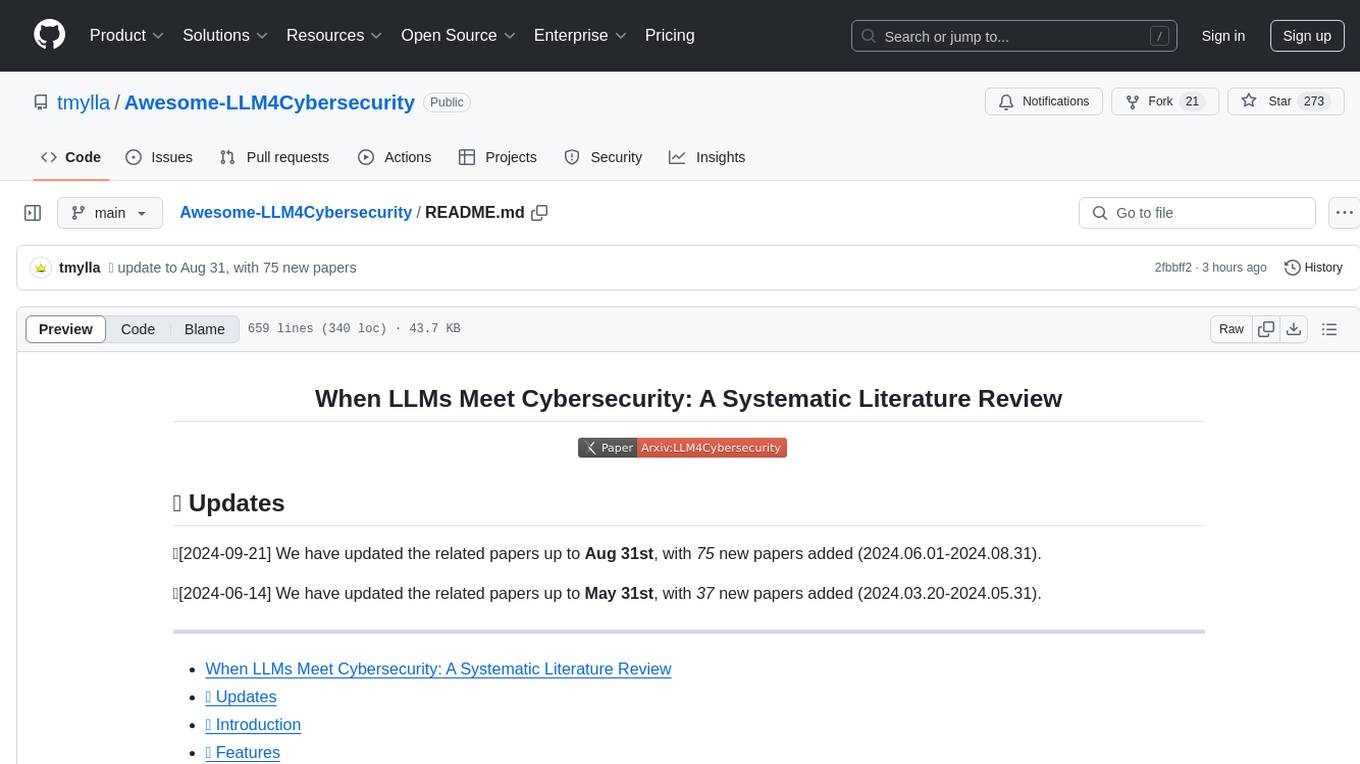
Awesome-LLM4Cybersecurity
The repository 'Awesome-LLM4Cybersecurity' provides a comprehensive overview of the applications of Large Language Models (LLMs) in cybersecurity. It includes a systematic literature review covering topics such as constructing cybersecurity-oriented domain LLMs, potential applications of LLMs in cybersecurity, and research directions in the field. The repository analyzes various benchmarks, datasets, and applications of LLMs in cybersecurity tasks like threat intelligence, fuzzing, vulnerabilities detection, insecure code generation, program repair, anomaly detection, and LLM-assisted attacks.
For similar jobs

weave
Weave is a toolkit for developing Generative AI applications, built by Weights & Biases. With Weave, you can log and debug language model inputs, outputs, and traces; build rigorous, apples-to-apples evaluations for language model use cases; and organize all the information generated across the LLM workflow, from experimentation to evaluations to production. Weave aims to bring rigor, best-practices, and composability to the inherently experimental process of developing Generative AI software, without introducing cognitive overhead.

LLMStack
LLMStack is a no-code platform for building generative AI agents, workflows, and chatbots. It allows users to connect their own data, internal tools, and GPT-powered models without any coding experience. LLMStack can be deployed to the cloud or on-premise and can be accessed via HTTP API or triggered from Slack or Discord.

VisionCraft
The VisionCraft API is a free API for using over 100 different AI models. From images to sound.

kaito
Kaito is an operator that automates the AI/ML inference model deployment in a Kubernetes cluster. It manages large model files using container images, avoids tuning deployment parameters to fit GPU hardware by providing preset configurations, auto-provisions GPU nodes based on model requirements, and hosts large model images in the public Microsoft Container Registry (MCR) if the license allows. Using Kaito, the workflow of onboarding large AI inference models in Kubernetes is largely simplified.

PyRIT
PyRIT is an open access automation framework designed to empower security professionals and ML engineers to red team foundation models and their applications. It automates AI Red Teaming tasks to allow operators to focus on more complicated and time-consuming tasks and can also identify security harms such as misuse (e.g., malware generation, jailbreaking), and privacy harms (e.g., identity theft). The goal is to allow researchers to have a baseline of how well their model and entire inference pipeline is doing against different harm categories and to be able to compare that baseline to future iterations of their model. This allows them to have empirical data on how well their model is doing today, and detect any degradation of performance based on future improvements.

tabby
Tabby is a self-hosted AI coding assistant, offering an open-source and on-premises alternative to GitHub Copilot. It boasts several key features: * Self-contained, with no need for a DBMS or cloud service. * OpenAPI interface, easy to integrate with existing infrastructure (e.g Cloud IDE). * Supports consumer-grade GPUs.

spear
SPEAR (Simulator for Photorealistic Embodied AI Research) is a powerful tool for training embodied agents. It features 300 unique virtual indoor environments with 2,566 unique rooms and 17,234 unique objects that can be manipulated individually. Each environment is designed by a professional artist and features detailed geometry, photorealistic materials, and a unique floor plan and object layout. SPEAR is implemented as Unreal Engine assets and provides an OpenAI Gym interface for interacting with the environments via Python.

Magick
Magick is a groundbreaking visual AIDE (Artificial Intelligence Development Environment) for no-code data pipelines and multimodal agents. Magick can connect to other services and comes with nodes and templates well-suited for intelligent agents, chatbots, complex reasoning systems and realistic characters.






























